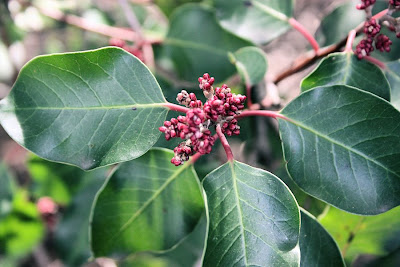 It's spring here in the southland. New growth, buds and blooms are everywhere. I have been taking lots of photos but haven't had time to post them. It's time to get a little caught up.
It's spring here in the southland. New growth, buds and blooms are everywhere. I have been taking lots of photos but haven't had time to post them. It's time to get a little caught up.Master C. and I have been on two canyon walks together at Oak Canyon where I became acquainted with some new native California plants. Master C. is becoming quite the hiker, taking off on any trail that piques his curiosity and commanding me to follow him. On our first hike, I took a wrong turn at one point and instead of coming back down into the canyon, we ended up going along the rim and it took forever to get back. By this time, Master C. had grown tired and I ended up carrying him most of the way down back into the canyon. Next time, I will bring along a map!
 Before I get into the plants, however, I just have to post this photo of a male Wood Duck. Isn't he handsome? A large group of ducks have spent the winter in the canyon and hadn't left yet when this photo was taken on March 6th. Wood Ducks are my favorite ducks because the male is so colorful and because they are fun to watch. The reason that they like this canyon so much is because they like to build their nests on low branches that overhang water and with all the spreading oak trees along the year-round running stream, the canyon offers them plenty of choices. After the eggs hatch, the little ones just drop or plop down into the water and off they go.
Before I get into the plants, however, I just have to post this photo of a male Wood Duck. Isn't he handsome? A large group of ducks have spent the winter in the canyon and hadn't left yet when this photo was taken on March 6th. Wood Ducks are my favorite ducks because the male is so colorful and because they are fun to watch. The reason that they like this canyon so much is because they like to build their nests on low branches that overhang water and with all the spreading oak trees along the year-round running stream, the canyon offers them plenty of choices. After the eggs hatch, the little ones just drop or plop down into the water and off they go.Now for the plants. Because the canyon has both Sugar Bush and Lemonadeberry, and they are both blooming now (or about to bloom), I was able to finally fix in my head the differences between the two. These two photos will illustrate. The first one is Sugar Bush, Rhus ovata, and the second is the Lemonadeberry, Rhus integrifolia. Generally, Sugar Bush is not found close to the ocean but notice also the red stems, the smoother leaf edges, and the darker, shinier leaves that curl inward like a taco. The Lemonadeberry leaf has teeth, although this is not always true. When the Sugar Bush blooms open up, I will be able to compare the flowers in detail.

Lemonadeberry, Rhus integrifolia
And now, in no special order, here are some of the new native plants I found.

Fuschia-flowered Gooseberry, Ribes speciosum
 Baby Blue Eyes, Nemophila menziesii
Baby Blue Eyes, Nemophila menziesii
Miner's Lettuce, Claytonia perfoliata

Blue Dicks, Dichelostemma capitatum

This last link shows some fabulous photos of Parry's Phacelia mixed with California Poppies and lupine. The phacelia is the dark purple flower in my photo.

Over at my dads on the hill behind his house, my sister and I use to play by the creek. We would collect these purple flowers (Blue Dicks, Dichelostemma capitatum). Now I can say I know the name.
ReplyDeleteMMK-AKA-DIL-LOL